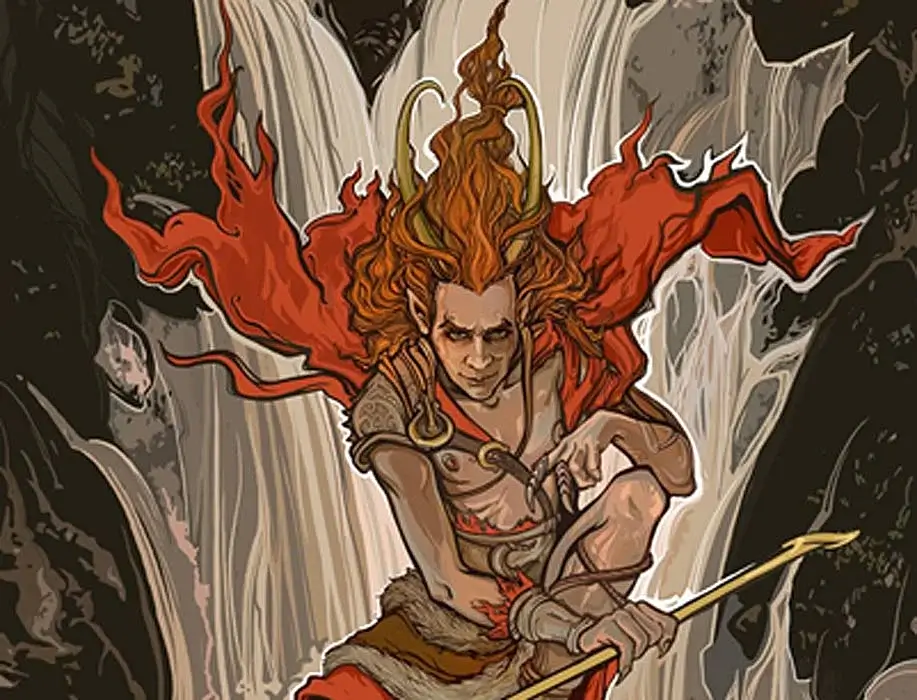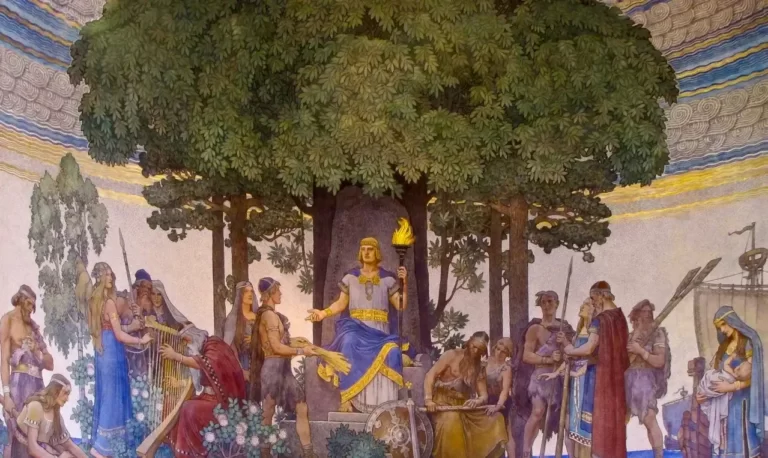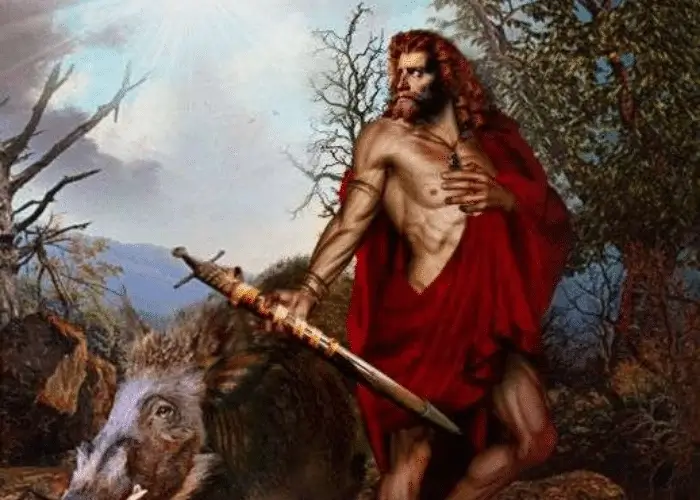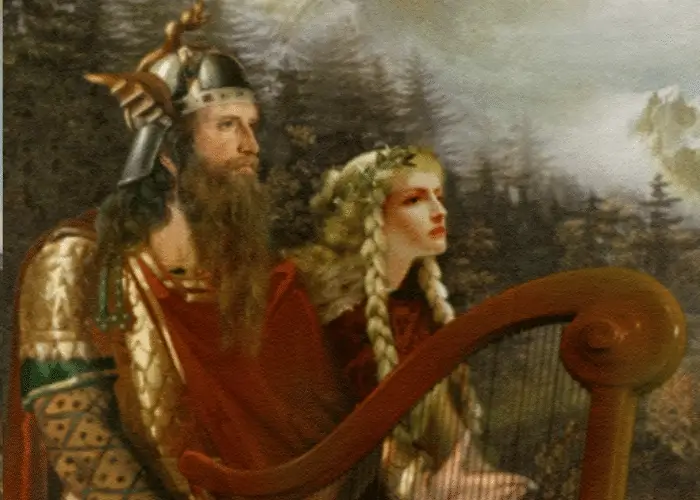Loki The God of Mischief: Norse Mythology
In Norse mythology, Loki is the god of mischief and trickery. He is often portrayed as a cunning and mischievous figure who causes trouble for both gods and humans. Loki is also known for his role in the story of the death of the god Baldr.
Loki is married to the giantess Sigyn, with whom he has two children, Narfi and Vali. In some stories, Loki is also said to have an affair with the goddess Freyja.
Loki is often depicted as a snake or serpent, and in some stories, he transforms into various animals. He is also associated with fire, both as a creator of fire and as a bringer of destruction.
Origins of Loki The God of Mischief
Loki is a god of mischief in Norse mythology. He is the son of two giants, Fasolt and Fafnir. Loki is known for his trickery and deceit. He is often depicted as a serpent or dragon.
Loki was born into a family of giants. His father, Fasolt, was killed by Odin during the war between the giants and the gods. His mother, Fafnir, was turned into a dragon by Odin. Loki grew up in the company of giants and dragons. He learned their ways of trickery and deception.
Loki became known as the god of mischief after he tricked Thor into losing his hammer, Mjolnir. Loki also tricked Hodr into killing Baldr, which led to Baldr’s death. Loki’s tricks often caused problems for the gods and mortals alike. He was eventually captured and chained by the gods. He is also known as a shapeshifter. Loki’s wife, Sigyn, would catch his venom in a bowl each time he was about to be bitten by the snake that was placed above him.
Pranks and Deeds Loki has pulled off in Norse mythology
Loki, the god of mischief, is known for his many pranks and deeds. Some of the more famous (or infamous) tricks Loki has pulled off in Norse mythology include:
- how Loki convinces Hodr to blind Thor
Loki the god of mischief was always up to no good. In one of his many mischievous acts, he convinced Hodr to blind Thor. Loki told Hodr that if he wanted to be as powerful as Thor, he needed to sacrifice his eyesight. Hodr believed Loki and sacrificed his eyesight for power. This act not only blinded Thor but also created a rift between the two brothers that would never be healed.
- Loki binding Fenrir
Loki is said to have bound Fenrir, the giant wolf son of Loki, and the giantess Angrboda. Fenrir was so powerful that he could not be killed by any weapon in existence, so the gods decided to bind him with magical chains. It is said that this was Loki’s idea. After Fenrir was bound, he bit at the shackles, and to this day, he remains imprisoned beneath a giant tree in Niflheim.
- Loki stealing Idunn’s apples of youth
Loki, the god of mischief, is known for his many tricks and pranks. One of his most famous is when he stole Idunn’s apples of youth. Idunn was the goddess of immortality and her apples allowed the gods to stay young forever. When Loki stole them, the gods began to age and they were not happy. Loki was eventually caught and punished for his misdeeds. Even though he is known as the god of mischief, Loki can also be a force for good. He is often portrayed as a trickster, but he is also a loyal friend and ally.
- Loki causing Baldr’s death
Loki, the god of mischief, is responsible for the death of Baldr, one of the most beloved gods in Norse mythology. Baldr was killed by a spear made of mistletoe, which was given to Loki by the giant Thokk. Loki Trickster God used his cunning and mischief to convince Hodr, Baldr’s blind brother, to throw the spear at him. Hodr did not know that it would kill Baldr because Loki had promised that no harm would come to Baldr. This tragic event caused great pain and suffering for all the gods and goddesses. It also resulted in Loki’s punishment: he was bound in chains by the god Heimdall until Ragnarok.
- Loki tricks Sif into cutting her own hair
Loki was known for his cunning and mischief. He often used his trickery to cause trouble for others. In one instance, he tricked Sif into cutting her own hair. Sif was a beautiful goddess with long, golden hair. Loki convinced her that she would look even more beautiful if she cut her hair short. Sif believed him and cut off her own hair. When she saw her reflection, she realized that Loki had tricked her. She was so angry that she chased him all the way back to Asgard.
- Loki impersonates Freyja to deceive Bragi
In one instance, he impersonated Freyja, the goddess of love and beauty, to deceive Bragi, the god of poetry. Loki cunningly convinced Bragi to give him a poetry lesson, during which he recited a poem that was so filled with errors that Bragi was left speechless. When Freyja discovered Loki’s deception, she was so angry that she turned him into a snake.
- Loki kidnapping Idunn and her apples
Loki, the god of mischief, was always up to no good. One of his favorite pranks was kidnapping Idunn and her apples. Idunn was the goddess of youth and her apples kept the gods young. Without them, the gods would age and die. Loki knew this and thought it would be funny to take her away from the others.
One day, Loki tricked Idunn into leaving Asgard and followed her into the forest. There, he snatched her up and took her away to a hidden cave. The other gods soon realized she was missing and went looking for her. They found Loki’s cave and demanded he returns Idunn to them.
Loki didn’t want to give her back, but he had no choice. The other gods threatened to kill him if he didn’t return to Idunn unharmed.
- Loki causes Thor to kill his servant Thjalfi
Loki is the God of Mischief and is known for causing trouble. In one story, Loki causes Thor to kill his servant Thjalfi. Thor and Loki were traveling together when they came across a farmhouse. They asked the farmer if they could stay for the night and he agreed. However, he said that they would have to sleep in the barn with his servant, Thjalfi.
Loki did not want to sleep in the barn, so he caused trouble. He whispered to Thor that Thjalfi was going to steal their things. Thor got angry and killed Thjalfi with his hammer. When the farmer found out what happened, he was very angry and chased Loki and Thor away from his property.
- Loki causes Thor to kill the giantess (and lover) Thyr
Loki is known for causing trouble, and in one story, he caused Thor to kill the giant Thyr. Thor was Loki’s brother, and Thyr was his lover. Loki tricked Thor into thinking that Thyr was a monster, and Thor killed her. This caused a great rift between the two brothers, and they were never able to reconcile.
- Loki giving birth to Sleipnir
Loki, the god of mischief, was known for his trickery and cunning. He was also responsible for some of the most important events in Norse mythology, including the birth of Sleipnir, the world’s greatest horse.
Loki was married to Sigyn, and they had two children together, Narvi and Vali. However, Loki also had an affair with Angrboda, a giantess who bore him three children: Hel, Jormungandr, and Fenrir. These illegitimate children were considered monsters by the gods and were banished from Asgard.
Loki’s most famous son is Sleipnir, who was born when Loki transformed himself into a mare and seduced Svadilfari, a giant stallion. Sleipnir was an eight-legged horse who could travel faster than any other horse in the world.
- Loki slaying Baldr’s foal, with the help of Odin and Hřnir
Loki is known for his mischievous nature, and he did not disappoint when it came to slaying Baldr’s foal. With the help of Odin and H nir, Loki was able to kill the foal and cause great sadness to Baldr. This act of mischief is just one example of why Loki is considered the god of mischief.
- Loki causes Sigyn to be trapped with a venomous snake above her head and for Loki to be bound next to her, as a punishment for killing Baldr
Loki, the god of mischief, did not always have such a mischievous nature. In fact, he was once a loyal and loving husband to Sigyn. But that all changed when he was bound by the gods for his crimes.
Since then, Loki has been trapped in a cave with a venomous snake above his head, and Sigyn has been forced to catch the drips of poison in a bowl. It is a never-ending cycle of pain and misery for both Loki and Sigyn, but they remain together out of love and loyalty.
His Jotnar children
Loki is the god of mischief and chaos and is known for his trickery. He is the father of several Jotnar, or giants, including Fenris, Hel, and Jormungandr. Loki is a shapeshifter and often takes on the form of an animal, such as a snake or a bird. He is also known for his ability to transform into other beings, including women.
Loki’s children are as mischievous and chaotic as he is. Fenris is a giant wolf who was born with the ability to transform into a human form. Hel is the goddess of death and ruler of the underworld. Jormungandr is a giant serpent who encircles the world and bites its own tail.
All of Loki’s children are feared by gods and mortals alike. They are powerful beings with great strength and abilities.
The death of Baldr
In Norse mythology, Baldr was the son of Odin and Frigg. He was the god of light, beauty, and happiness. However, he had one flaw: he was afraid of dying. Loki, the god of mischief, learned of this and devised a plan to kill Baldr. He made a spear from a mistletoe plant and gave it to Baldr’s blind brother Hodr. Hodr accidentally killed Baldr with the spear while Loki looked on.
After Baldr’s death, Loki was pursued by the other gods. He fled to the underworld where he was captured and chained by Hel, the goddess of death. There he remained until Ragnarok when he would be freed to fight against the gods once again.
Loki’s punishment
After Loki’s many crimes, the gods had had enough. They bound him with their strongest chains and left him to hang from a tree until Ragnarök came to claim him. This was not enough for Odin though. He wanted to make sure that Loki suffered for his part in the death of Baldr. He took a venomous snake and placed it above Loki’s head, letting the poison drip down onto his face. For all eternity, Loki will be in agony, his body contorting in pain as the venom burns away at his flesh.
The end of Loki
Loki is one of the most popular gods in Norse mythology. He is the god of mischief and trickery and is known for his cunning and clever deeds. Loki is also responsible for some of the most famous stories in Norse mythology, including the story of Ragnarok, the end of the world.
Conclusion:
Loki, the god of mischief, is one of the most intriguing figures in Norse mythology. He is known for his cunning and deceit, as well as his ability to shape-shift into different forms. Loki is also responsible for some of the most famous stories in Norse mythology, including the theft of Freya’s necklace and the death of Baldr. Despite his mischievous nature, Loki is also a complex figure who is capable of both good and evil. This makes him an interesting and compelling character that continues to fascinate people today.
Most Frequently Asked Questions
Loki: a trickster God
Loki is a trickster god from Norse mythology who is known for his cunning and ability to shape-shift. He is also associated with the jötunn, or giants, and is said to be responsible for Ragnarok, the end of the world.
Was Loki male or female?
In Norse mythology, Loki is a male god. He is the son of Odin and the jötunn Angrboða. Loki is the brother of Thor and Freyja. He is known for his trickery and deceit.
Loki must serve a term of imprisonment after causing the death of Baldr. He returns to Asgard after escaping from his prison.
Loki can transform himself into different shapes. He takes the form of an eight-legged horse named Sleipnir. Sleipnir is the steed of Odin.
Loki is also associated with fire.
Was Loki a ‘typical’ god?
Loki is a god in Norse mythology who is often associated with trickery and deception. He is the son of Odin and the giantess Angrboda and is the brother of Thor. Loki is also the father of the monsters Fenrir and the serpent Jörmungandr. In some stories, he is bound to a rock by his entrails after causing the death of Odin’s son Baldr.
Ragnarok, Heimdall, and Loki’s Death
Ragnarok is a prophesied event in Norse mythology that will result in the death of most of the gods, including Odin and Loki. Heimdall is a god who will sound the horn that signals the start of Ragnarok, and Loki is a trickster god who will be killed by Odin’s son Thor. Asgard is the home of the gods, and it is where Ragnarok will take place.
Myths Involving Loki
Loki is a figure in Norse mythology who is known as the god of mischief. He is often depicted as a trickster god who causes trouble for Thor, Sif, and other gods and goddesses in Asgard. In one famous story, Loki insulted Freyja and she cursed him for having to give birth to a horse. This horse, named Sleipnir, was an eight-legged stallion that could run faster than any other horse. Loki also had a wife named Sigyn who was very loyal to him. In another story, Loki tricked Freya into giving him her necklace in exchange for his help in finding her missing husband. Loki is an important figure in Norse mythology and is one of the most well-known Norse deities.
Symbols of Loki
In Norse mythology, Loki is the god of mischief. He is often represented as a serpent or dragon, and he is known for his trickery and deception. Loki is also associated with fire, and he is sometimes depicted carrying a torch.
Loki’s offspring
Loki’s offspring include Sleipnir, the eight-legged horse, and Fenrir, the serpent. Loki is also the father of Hel, the goddess of the underworld. Loki gave birth to Sleipnir after mating with a mare who was transformed into a stallion by Odin. Fenrir was born when Loki mated with a giant serpent.
Loki and Sleipnir
Loki is a god of mischief and mayhem and is known for his trickery and deceit. He is also the father of Sleipnir, the eight-legged horse of Odin. Loki is associated with fire and is said to be able to change his shape. In Norse mythology, Loki is often portrayed as a villain, but he is also sometimes seen as a friend of the gods.
Quick Facts: Loki, the God of Mischief
- Loki is one of the most complex and fascinating figures in Norse mythology.
- He is known as the God of Mischief, Trickster, and Chaos.
- Loki is the son of two giants, Laufey and Farbauti.
- Despite being a god, he is often depicted as an outsider in Norse mythology.
- Loki is the father of many creatures, including Hel, the goddess of the underworld.
- He is also the father of the giant wolf Fenrir and the world serpent Jormungandr.
- Loki is the blood brother of Odin, the king of the gods.
- He is a shape-shifter and can transform into any animal he desires.
- Loki has a reputation for being deceitful and cunning.
- He is often portrayed as a trickster who plays pranks on the other gods.
- Loki is responsible for the death of Baldr, the god of light and purity.
- Baldr’s death leads to Ragnarok, the end of the world in Norse mythology.
- Despite his mischievous nature, Loki is sometimes depicted as a heroic figure.
- He is one of the few Norse gods who have a sense of humor.
- Loki is often seen as a symbol of chaos and change.
- He is associated with fire, as he is said to be a fire giant.
- Loki is said to have fathered Sleipnir, Odin’s eight-legged horse.
- He is sometimes referred to as the “father of lies.”
- Loki is a shape-shifter and can turn into anything he desires, from a fly to a seal.
- He is also a skilled magician and is known for his magical abilities.
- Loki is often seen as a trickster who enjoys causing chaos and confusion.
- He is said to be incredibly handsome and charming.
- Loki is often depicted with a mischievous grin or a sly smile.
- He is a master of disguise and can easily blend in with his surroundings.
- Loki is often seen as a figure of rebellion against authority.
- He is sometimes associated with the idea of individual freedom.
- Loki is said to be the patron god of thieves and outcasts.
- He is also associated with fertility and sexuality.
- Loki is known for his quick wit and sharp tongue.
- He is often depicted as a witty conversationalist who can talk his way out of any situation.
- Loki is often seen as a figure of transformation and change.
- He is associated with the changing of the seasons and the cycles of life and death.
- Loki is often portrayed as a lover of chaos and disorder.
- He is sometimes seen as a force of nature, like a thunderstorm or a wildfire.
- Loki is often depicted as a figure of mischief and playfulness.
- He is associated with laughter and humor.
- Loki is said to have a love-hate relationship with the other gods.
- He is often seen as a figure of ambiguity and contradiction.
- Loki is sometimes portrayed as a tragic figure, misunderstood by the other gods.
- He is often seen as a symbol of the dangers of unchecked chaos and rebellion.
- Loki is sometimes depicted as a figure of redemption and renewal.
- He is associated with the idea of rebirth and resurrection.
- Loki is sometimes seen as a figure of creativity and invention.
- He is associated with the idea of innovation and progress.
- Loki is often depicted as a figure of duality and contradiction.







Like!! I blog quite often and I genuinely thank you for your information. The article has truly peaked my interest.